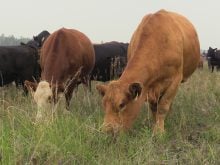This cattle market information is selected from the weekly report from Canfax, a division of the Canadian Cattlemen’s Association. More market information, analysis and statistics are available by becoming a Canfax subscriber by calling 403-275-5110 or at www.canfax.ca.
Slaughter rates up
More than 50,000 more fed cattle have been slaughtered in Western Canada since the beginning of the year when compared to numbers last year. Fed cattle supplies are being aggressively managed. On top of high slaughter rates, carcass weights continue to run above last year, adding to total production output.
Read Also

Geopolitics can change trade routes
WHISTLER, B.C. — Today’s geopolitical tensions could have dire long-term consequences, says the director of international policy at the University…
Year to date, western Canadian fed beef production is up 17 percent compared to last year, while fed prices are averaging around four percent below last year.
Domestic and export demand continues to be strong — Canadian beef exports for January were up nine percent compared to last year. Based on the five-year average, fed prices should trend higher over the next 30 days.
Fed cattle prices saw a modest pull back last week and were at the lowest point in seven weeks. Dressed sales ranged from $249-$251 per hundredweight delivered, and a weaker price tone was noted last week. Both major packers were on the cash market, and cattle were being scheduled for the week of April 5 and April 12 delivery.
Western Canadian fed slaughter for the week ending March 6 totalled 41,123 head. For the start of March it was the largest slaughter since 2005. There have been reports that packers are slow in taking delivery. Cattle in some cases are one week behind schedule compared to their original pick-up date.
In Ontario, dressed sales were reported from $240-$243 per cwt. delivered. Sales were steady to $2 per cwt. lower than the previous week. Even though eastern Canadian steer carcass weights are 22 pounds larger than last year, fewer cattle are grading four and five. Last year 22.3 percent had a yield grade of four or five, compared to 20.7 percent this year.
In the United States last week, dressed sales were reported from US$178-$180 per cwt., steady to $1 per cwt. lower than the previous week. Live sales in the southern U.S. ranged from $113-$114 per cwt., steady to $1 per cwt. lower. The all-fresh beef retail price for February was reported at $6.30 per lb., six percent higher than last year.
U.S. beef exports for the month of January were fully steady with last year. More U.S. beef was shipped to China, Sough Korea and Canada, but year-over-year declines were noted in Hong Kong, Japan and Mexico.
Uneven cow trade
Non-fed cattle prices were mixed last week with slaughter cows trading unevenly and butcher bull prices lower. D2 slaughter cow prices continued steady with the previous week, averaging $86 per cwt., while D3s saw a modest $1 per cwt. decline to average $75.25.
Butcher bull prices eased almost $2 per cwt. lower than the previous week to average $104.79 per cwt.
Ontario slaughter cow prices softened modestly last week on ample offerings, and Alberta cows traded at around a $12 per cwt. premium. Western Canadian non-fed slaughter for the week ending March 6 was up nine percent from the previous week to 8,166 head, and year to date was 16 percent lower at 68,564 head.
Seasonal grind demand is expected to strengthen as grilling weather improves. D2 prices historically rally higher and peak in May.
Auction marts busy
Auction volumes have trended significantly larger than a year ago for the previous three weeks, and good demand was seen for large lots of quality feeders. Mid-weight 500-700 lb. steer calves traded steady with the previous week, and similar weight heifers saw prices modestly higher.
Large feeders heavier than 700 lb. traded mixed with steers easing $1.50 per cwt. lower than the previous week. Heifers realigned $2 per cwt. higher.
Total weekly auction volumes were seasonally large at 41,439 head but were 18 percent lower than the previous week. Alberta year-to-date auction volumes were 29 percent larger than a year ago, totalling 286,596 head, and are 18 percent larger than the year-to-date five-year average.
Canadian feeder exports to the U.S. for the week ending Feb. 27 surged 15 percent larger than the previous week but remained light at 1,884 head.
Backgrounders are expected to continue as motivated sellers thanks to strong prices and reduced feedstocks. Peak spring auction volumes are likely over, and the show alley should see numbers tighten.
Broad-based grass and feedlot demand should continue for calves this week, and prices are anticipated mostly steady. Large feeders continue to provide a cheaper feeding option toward a marketable fed animal in contrast to feeding near $7 per bushel barley to calves.
Alberta steer calf prices traded at a modest premium to Ontario last week, while 850 lb. steers traded at parity. Ontario feeder heifers traded at a marked discount.
Bred cows traded from $1,450-$2,225 per head and bred heifers at $1,550-$2,650.
Choice takes a plunge
In U.S. beef trade, cut-out values aligned lower last week with Choice down sharply by US$7.21 per cwt. to average $226.67. Select was also down by $1.61 per cwt. to average $220.07.
Fresh 90 percent U.S. trim firmed modestly higher last week on improved spring grilling and export demand. Total U.S. slaughter for last week was estimated around one percent larger than a year ago at 647,000 head.














